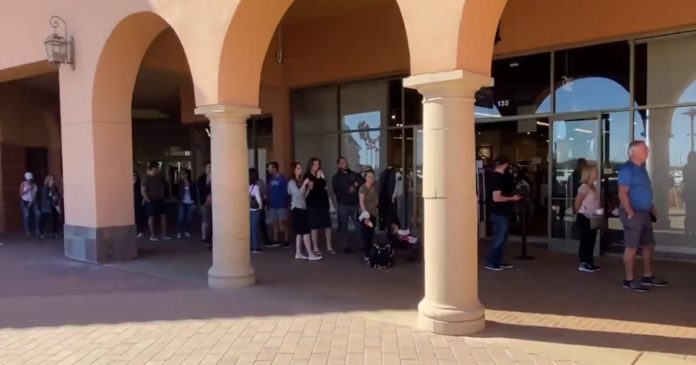With the first round of counting over, and the battle just barely beginning, some preliminary shots are being fired in what is expected to be a bruising post-election struggle over which ballots should be counted in the race to become Arizona’s governor.
Media organizations have proclaimed Democrat Katie Hobbs the winner, although the gap between her and Republican Kari Lake is less than 20,000 votes, which means even in the best of times, a recount would be held.
But these are not the best of times. With trust in short supply and scars from the state’s battles over the 2020 election results still fresh, both sides are digging in, lawyering up and firing broadsides at the other before the recounting and lawsuits begin.
According to a report in Time, Lake’s campaign spent $2 million to monitor the counting of votes and to be prepared with lawsuits based on the facts when necessary. Time said 40 lawyers were in one central “war room” while roving attorneys monitor polling places and vote-counting operations.
“This is the most robust Election Day operation and post-election operation that Arizona has ever seen,” Brady Smith, the Lake campaign’s chief political strategist, said.
A glimpse at what the Lake campaign might use as fodder for its lawsuits was shared with The Western Journal in the form of a report from Mark Sonnenklar about what the roving attorneys saw on Election Day. The Western Journal has not independently verified the claims in this report.
Sonnenklar said 10 roving attorneys out of 16 responded to a survey he sent them, and that his report covers 115 voting places out of the 223 places in Maricopa County.
Overall, he wrote, “72 of the 115 vote centers (62.61%) we visited had material problems with the tabulators not being able to tabulate ballots, causing voters to either deposit their ballots into box 3, spoil their ballots and re-vote, or get frustrated and leave the vote center without voting.”
“In many vote centers, the tabulators rejected the initial insertion of a ballot almost 100 percent of the time, although the tabulators might still accept that ballot on the second, third, fourth, fifth, or sixth attempt to insert the ballot,” he wrote.
Did delays and errors in Arizona have a significant impact on the elections?
“However, many ballots were not able to be tabulated by the tabulators at all, no matter how many times the voter inserted the ballot. The percentage of ballots that were not able to beread at all by the tabulators ranged from 5% to 85% at any given time on election day, with the average being somewhere between 25 percent and 40 percent failure rates,” he wrote.
Sonnenklar noted that at many polling places, “the printer/tabulator issues persisted from the beginning of election day until the end of election day.”
The report identified a presumed cause of the glitch
“The strong consensus regarding why the tabulators would not read certain ballots was that those ballots, in particular the bar codes on the side of the paper, were not printing dark enough for the tabulators to read them,” he wrote.
The report said the findings contradict county officials that only 70 polling places had issues and that they were “insignificant in the entire scheme of the election.
The other major finding in the report was that at “59 of the 115 vote centers we visited (51.30%). In many cases, voters had to wait 1-2 hours before they received a ballot for voting.”
Sonnenklar noted that “because Republican voters significantly outnumbered Democrat voters in the County on election day, such voter suppression would necessarily impact the vote tallies for Republican candidates much more than the vote tallies for Democrat candidates.”
Sonnenklar tied the two issues together.
“It seems very clear that the printer/tabulator failures on election day at 62.61 percent of the vote centers observed by 11 roving attorneys, and the resulting long lines at a majority of all vote centers, led to substantial voter suppression,” he wrote.
As mentioned above, while The Western Journal did not independently verify the findings of this report, reporter Randy DeSoto did visit a polling location that clearly showed an aggressively long line to cast a vote:
The issues were on the minds of several people attending a Nov. 16 meeting of the Maricopa County Board of Supervisors, according to KUTP-TV.
“You look into your own soul, and you look back at yourself in the mirror, and realize you are the cancer that is tearing this nation apart,” resident Matt Baker said.
“You need to resign,” Lizette Lindt said. “You need to resign today, and I pray that God is going to convict your heart.”
This article appeared originally on The Western Journal.


